 Event Briefing - Covered Area Rainfall Event - Excess Rainfall - Jamaica - September 6 2021
Event Briefing - Covered Area Rainfall Event - Excess Rainfall - Jamaica - September 6 2021 |
Jamaica was affected by a tropical wave and Tropical Cyclone Ida resulting in adverse weather conditions that occurred in the period between 26 August and 28 August, 2021. During this period, Jamaica was affected by moderate to heavy rainfall. |
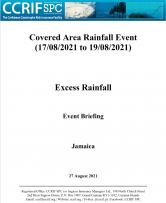 Event Briefing - Covered Area Rainfall Event - Excess Rainfall - Jamaica - August 27 2021
Event Briefing - Covered Area Rainfall Event - Excess Rainfall - Jamaica - August 27 2021 |
Jamaica was affected by Tropical Cyclone Grace, which caused adverse weather conditions that occurred between 17 August and 18 August, 2021. During this period, Jamaica was affected by heavy rainfall. |
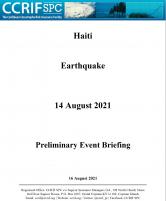 Preliminary Event Briefing - Earthquake - Haiti - August 14 2021
Preliminary Event Briefing - Earthquake - Haiti - August 14 2021 |
A magnitude 7.2 earthquake occurred at 12:29:08 (UTC) on 14 August 2021, 6.4 km (3.9 mi) ENE of L’Asile, Haiti; 12.3 km (7.7 mi) SSW of Saint-Louis-du-Sud, Haiti and 11.9 km (7.4 mi) SE of Aquin, Haiti. Initial estimates from the United States Geological Survey (USGS) located the epicentre of the event at 18.352°N, 73.480°W, and at a depth of 10.0 km |
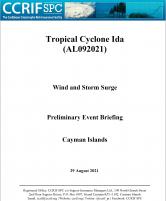 Preliminary Event Briefing - TC Ida - Wind and Storm Surge - Cayman Islands - August 29 2021
Preliminary Event Briefing - TC Ida - Wind and Storm Surge - Cayman Islands - August 29 2021 |
Tropical Cyclone Ida was the ninth named storm of the 2021 Atlantic Hurricane Season. On 26 August it developed as a tropical storm while it was over the central Caribbean Sea, east of Jamaica. On 27 August, Tropical Storm Ida moved through the Cayman Islands, passing approximately 30 mi (50km) from Grand Cayman. Tropical-storm-force winds occurred across this country. In the following days, Ida rapidly strengthened while traversing the Gulf of Mexico, becoming a major hurricane. |
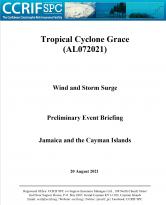 Preliminary Event Briefing - TC Grace - Wind and Storm Surge - Jamaica and the Cayman Islands - August 20 2021
Preliminary Event Briefing - TC Grace - Wind and Storm Surge - Jamaica and the Cayman Islands - August 20 2021 |
Tropical Cyclone (TC) Grace was the seventh tropical cyclone in the 2021 Atlantic Hurricane Season. Reported on 13 August as Potential Tropical Cyclone Seven, it was soon upgraded to Tropical Depression Seven and consequently, to Tropical Storm Grace, which was first identified as a small tropical storm. On 14 August at 1500 UTC, it became stronger and resulted in stormy weather with heavy rainfall across the Lesser Antilles. On 15 August the NHC reported that Tropical Storm Grace became a tropical depression again. |
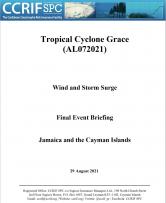 Final Event Briefing - TC Grace - Wind and Storm Surge - Jamaica and the Cayman Islands - August 29 2021
Final Event Briefing - TC Grace - Wind and Storm Surge - Jamaica and the Cayman Islands - August 29 2021 |
On 15 August the NHC reported that Tropical Storm Grace became a tropical depression again. On 16 August, at 1200 UTC the Government of Jamaica issued a Tropical Storm Watch for Jamaica and at 1500 UTC the same day the Government of the Cayman Islands issued a Tropical Storm Warning for the Cayman Islands. Over 17 and 18 August, Tropical Depression Grace gradually strengthened becoming a tropical storm again as it approached Jamaica and the Cayman Islands, which resulted in heavy rains and gusty winds in both countries. |
 Event Briefing - Covered Area Rainfall Event - Excess Rainfall - Trinidad and Tobago - August 28 2021
Event Briefing - Covered Area Rainfall Event - Excess Rainfall - Trinidad and Tobago - August 28 2021 |
Trinidad was under the influence of two tropical waves and the presence of the Inter Tropical Convergence Zone resulting in adverse weather conditions that occurred primarily between August 17 and August 20, 2021. During this period, Trinidad was affected by periods of intense rainfall and thunderstorm activity. |
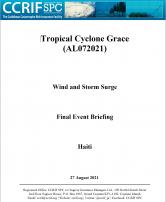 Final Event Briefing - TC Grace - Wind and Storm Surge - Haiti - August 27 2021
Final Event Briefing - TC Grace - Wind and Storm Surge - Haiti - August 27 2021 |
Tropical Cyclone (TC) Grace was the seventh tropical cyclone in the 2021 Atlantic Hurricane Season. Reported on 13 August as Potential Tropical Cyclone Seven, it was soon upgraded to Tropical Depression Seven and on 14 August it upgraded to Tropical Storm Grace which was first characterized as a small tropical storm. On the same day at 1500 UTC, it became stronger and resulted in stormy weather with heavy rainfall across the Lesser Antilles. On 15 August at 0300 UTC, a Tropical Storm Watch was issued for the entire coast of Haiti. Later that day, the |
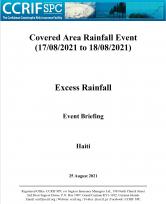 Event Briefing - Covered Area Rainfall Event - Excess Rainfall - Haiti - August 25 2021
Event Briefing - Covered Area Rainfall Event - Excess Rainfall - Haiti - August 25 2021 |
Haiti was affected by Tropical Cyclone Grace, which caused adverse weather conditions that occurred between 16 August and 17 August, 2021. During this period, Haiti was affected by intense rainfall. |
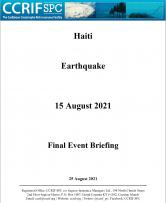 Final Event Briefing - Earthquake - Haiti - August 25 2021
Final Event Briefing - Earthquake - Haiti - August 25 2021 |
A magnitude 5.8 earthquake occurred at 03:20:45 (UTC) on 15 August 2021, 12.8 km (8 mi) NNE of Chardonnière, Haiti; 42.2 km (26.2 mi) WNW of Les Cayes, Haiti and 106.9 km (66.4 mi) W of Miragoâne, Haiti. Estimates from the United States Geological Survey (USGS) located the epicentre of the event at 18.371°N, 74.099°W, and at a depth of 12.0 km. |

